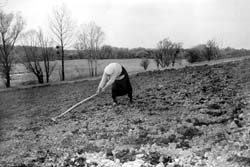6.5 million smallholders left to face the market on their own

Credit Union Hromada [Community] has been of late gaining greater popularity in Kherson oblast. The union is bringing into life an unfortunate Communist dream to form a linkage between the city and the village, receiving deposits from city residents and issuing loans to villagers. Developed with the help of the International Financial Corporation, Development of Agriculture in Ukraine, the procedure of issuing loans, which is based on the study of the capabilities of farms, enables both sides to function successfully. The more so that nobody else is issuing loans to small agricultural producers. Although modern so-called mutual assistance funds are still a novelty in Ukraine, in the Western regions in particular they have deep historical roots. Aside from Kherson oblast, credit unions have opened in Poltava and Zaporizhzhia oblasts. Unfortunately, they operate on a limited scale and thus far cannot effect major shifts in the agricultural sector.
After half a century of collective farming, Ukraine has seen a proliferation of individual smallholders after independence. Against a mere 43,000 farmers, there are 6.5 million individual farms or smallholders in Ukraine. Accordingly, they contribute significantly to the national foodstuffs production volumes. It is they who produce 70% of vegetables and potatoes and a major share of milk and meat. However, according to Valery Petrov, Vice President of the Association of Farmers and Land Owners, “the state budget does not provide even for a mite of assistance to this population stratum,” since the government policy, much like that of the banks, is aimed primarily at supporting major industries. And even credit unions that eagerly support farmers on the basis of guarantees and so-called loan circles do not consider smallholders their main clients. The latter can ill afford to pay interest on loans, which are twice as high in credit unions than those offered by the banks, which, for that matter, are closed for smallholders altogether. Meanwhile, loans with subsidized interest payments are out of the question. All of the above is evidenced by the fact that Deputy Minister of Agriculture Pavlo Haidutsky and Association of Ukrainian Banks President Oleksandr Suhoniako were not present for the press conference at the National Press Club of Reforms, with the banking circles represented only by an expert from Prokredytbank.
The problem is further aggravated by the fact that experts do not forecast high crop yields for major grain producers. According to Mr. Petrov, who has recently visited some of the country’s grain fields, winter crops are in a worse condition than last fall. Thus, next year Ukraine’s agriculture, which accounts for 25% of the country’s GDP, will heavily rely on smallholders. But they need seeds, fertilizers, and tools, let alone equipment and fodder. All of this cannot be bought without loans.
According to Mr. Petrov, Russia has created an institute of so-called governor’s loans. However, oblast councils in Ukraine are reluctant to create the respective funds within local budgets, citing the lack of instructions from the top or even opposition on the part of the parliament. Meanwhile, formal refusals are piling up in the Association of Farmers and Land Owners of Ukraine. Experts believe that a way out of this situation lies in the cooperation of the government not only with banks, but also with credit unions, using its experience of subsidizing interest payments on bank loans. Otherwise, Ukrainian countryside will have to be liquidated as a place, lifestyle, and a means of recreation of the nation.






